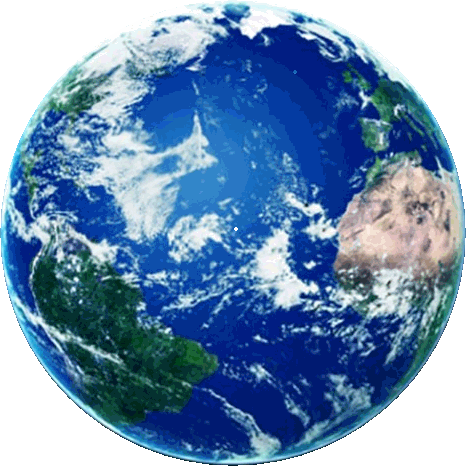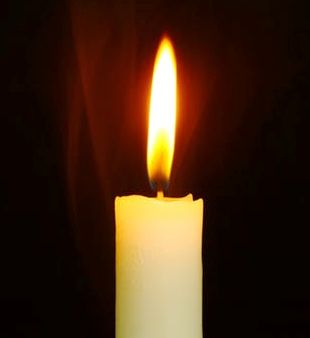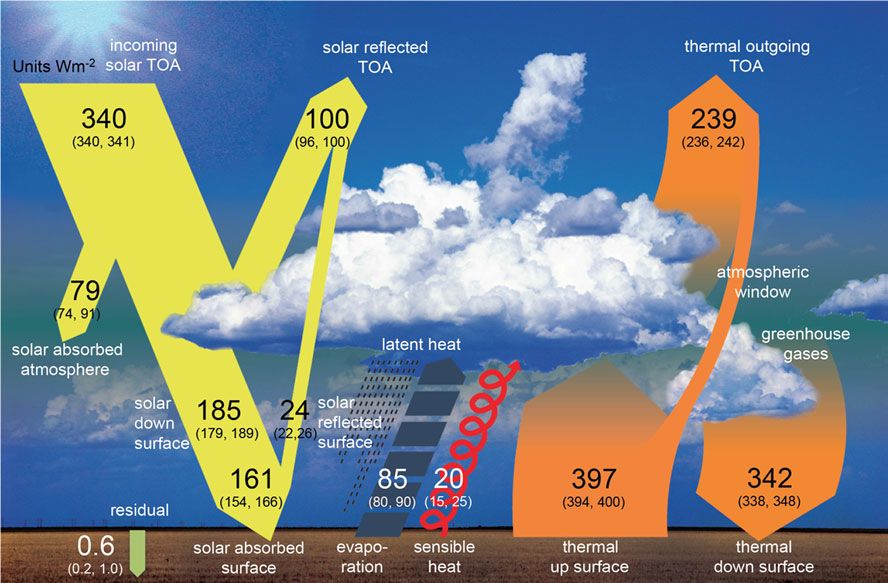|
|
Over dag en nacht en het aardoppervlak gemiddeld komt er van de zon een energiestroom van 340 Wm-2. 100 daarvan spiegelt terug, die laat geen warmte achter. Het overige bereikt de atmosfeer, de zee en de grond. De laatste twee stralen 397 Wm-2 naar buiten uit. Dat kan niet het uiteindelijk resultaat zijn. Dan zouden we snel bevriezen. Het komt volgens het plaatje doordat de atmosfeer weer 342 Wm-2 terug straalt naar grond en zee.
Die terugstraling vanuit de atmosfeer komt als een verrassing. Lucht is namelijk een slechte straler.
Ik deed een proefje met een kaars. Het was koud en de verwarming stond aan. Het water in de radiator in mijn kamer was ~ 60 °C. Ik hield mijn hand er voor op een afstand tussen 15 en 20 cm. Je voelt dan duidelijk de warmtestraling.
Daarna stak ik de kaars aan. Met mijn hand ter hoogte van de kaars zelf was er op diezelfde afstand uiteraard geen warmte voelbaar. Maar bewoog ik mijn hand tot op de hoogte van de vlam recht omhoog, dan was het duidelijk warm. Warmer dan bij de verwarmingsradiator. Vervolgens hield ik mijn hand weer zo'n 20 cm hoger en, weg was de warmte. Maar toen ik op diezelfde hoogte mijn hand horizontaal tot boven de vlam bewoog, moest ik hem snel wegtrekken. Anders brandde ik me.
De verklaring kwalitatief is simpel. De kaars zelf is gewoon op kamertemperatuur. Die straalt niet anders dan de omgeving. Maar de vlam is heet. Zo heet dat hij de lucht ioniseert. De vlam is geen gas. Het is een plasma. En plasma's stralen wel, en of! Gelukkig maar, want de zon is een plasmabol. Vandaar die warmte daar vandaan. Boven de vlam was er geen plasma, alleen erg hete lucht (met veel CO2 (!)). Veel heter dan mijn verwarmingsradiator. Toch was er opzij geen stralingswarmte.
Het experiment roept vragen op omtrent 342 Wm-2 terugstraling vanuit de atmosfeer, die in de klimaatwetenschap anno 2018 als vaststaand wordt aangenomen.
|
Averaged over day and night and over the surface of the earth, an energy flow of 340 Wm-2 comes from the sun. 100 reflects back, leaving no heat behind. The rest passes and affects the atmosphere and reaches the sea and the ground. The latter two beam out 397 Wm-2. That can not be the final result. Because then we would freeze quickly. According to the picture it is countered by atmospheric 'back radiation' at a rate of 342 Wm-2 towards ground and sea.
The back radiation from the atmosphere comes as a surprise. Air is in fact a bad radiator. I did a little experiment. It was cold outside and the heating was on. The water in the radiator in my room was ~ 60 °C. I held my hand at a distance between 15 and 20 cm. Clearly I felt the heat radiation.
Then I lighted a candle. With my hand at the level of the candle itself at the same distance, 15 - 20 cm, there was no warmth. But when I moved my hand straight up to the height of the flame, it was clearly warm. Warmer than with the radiator in my room. Then I held my hand again about 20 cm higher. No heat was felt. But when I moved my hand horizontally till above the flame, I had to pull it away quickly. Otherwise I would have burned myself.
The explanation - at least qualitatively - is simple. The candle itself is just at room temperature. It does not radiate differently from the environment. But the flame is hot. The air there ionizes. The flame is not just a gas. It is a plasma. And plasmas do shine. Good for us, because the sun is a plasma sphere. Hence that heat we are getting from there. Above the flame there was no plasma, only very hot air (with lots of CO2 (!)). Much hotter than my auxiliary radiator. Yet there was no radiant heat aside!
The experiment raises doubt about the 342 Wm-2 back radiation from the atmosphere, which in climate science in 2018 is assumed to be rock solid. To me it rather seems to be feather light.
|
|






